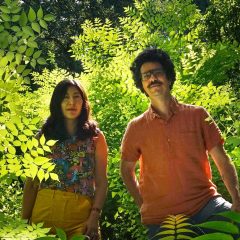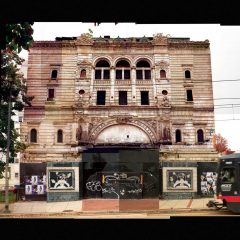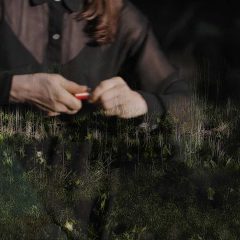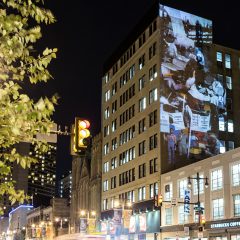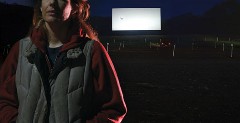
The Late Show video still
In conjunction with The Late Show, Nadia Hironaka’s nostalgic video installation at the Morris Gallery at the Pennsylvania Academy of the Fine Arts, she gave a talk last week on some of her past work and the thoughts behind the videos she makes (here’s a post from Roberta on Hironaka’s installation).
She said she was interested in the roles space and place play together in video.
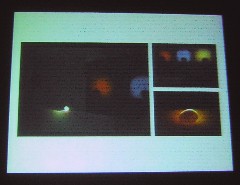
21 days 70°
She talked about how as a graduate student, she became interested in how, at the invisible point where an edit takes place, an idea is formed. So she created 21 days 70°, to capture on video the moment when an egg hatches; in her mind, capturing that moment represented capturing the moment when an idea happens. Alas, the egg didn’t hatch.
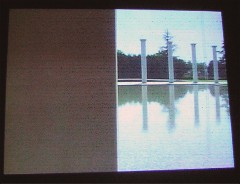
Groundskeepers
She talked about making two videos of places that were unpopulated–one a very old place in Italy, where groundskeepers who maintained the manicured gardens were the only people who ever appeared, and the other, the National restaurant supply building in Philadelphia’s Old City, where the business was closed but the papers and telephones remained. “It looked like people just left in a hurry,” she said. That, plus the 1950s renovation of the 1920s building gave “a sense of narrative through a single architectural space.”
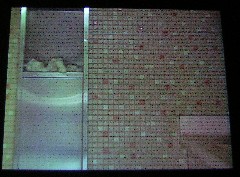
National
Versions of both those videos–National and “Groundskeepers–she then incorporated into My Stars, a version of which was shown at the Fabric Workshop and Museum. The two videos were shown in star-shaped holes in the wall lined with kaleidoscopic mirrors, and their sound tracks were samplings from science fiction movies (see post).
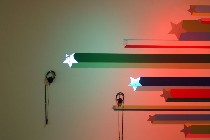
My Stars mural behind which two videos play, reflected in kaleidoscopic mirrors
Hironaka said she was thinking about how to bring together “inner space, images and sound.”
Then she said she “got lost,” felt like she was stuck in the present–an an “uncomfortable present,” while she was engaged, in the house a lot, looping in circles, and nervous about the future. That point in her life generated two videos–Light Switch Daydream and Home.
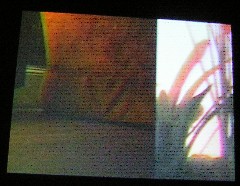
“Home”
In Home, she said, she used a VHS camera because old video was like “my own outdated views on women’s roles.” She used the kind of irritating static lines that appear when pausing old VHS tape as a key element in the video (see post).
She also used squeaking noises that reminded me of film misfed through a projector, static noise, and noir narration samples.
“I liked that visualization of the space between–that uncomfortable time.” She also liked the maddening loop of experience rolling by.
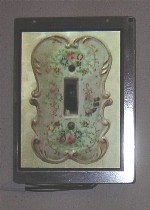
In Light Switch Day Dream, Hironaka was inspired by old, yellowed wallpaper in her new home. The video shows the wallpaper pattern on the switch as it goes from pretty to garish. The real-life-size wall switch is activated by a disembodied hand. The video was appropriately enough shown in an apartment show curated by Sean Stoops, displayed where a real switch would be likely to appear on a wall (see post).
A Girl Named Prism was about being stuck in a place where past, present and future are simultaneous. The times were color coded red, green and blue, and Prism is a scientist who must find the ruby, emerald and sapphire gems to create the time machine that will free her from the time warps. When all three are aligned, they are white. “She got it to work, but it’s not really answer the questions, and it’s experiencing the whole thing and not the final outcome that’s so important,” said Hironaka, apparently talking as much about herself as the video.
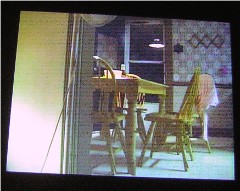
Vanitas
For the Faux Show, Vanitas was a play on the still life genre based on only 15 frames of video. Hironaka set herself the challenge of making something with such little footage. “It’s a comment on death,” she said, equating motion to life and lack of motion to death. The footage was shot at a house at the shore.
The sound track was from a song about happiness and love.
Hironaka said the The Late Show is about a drive-in movie. “I am more and more intrigued with narrative,” i.e. what happens when a narrative from one placeis relocated to a different kind of space, thereby creating a virtual space.
compared what she was doing with sound to the Newsweek photo of Martha Stewart under house arrest, looking free as a bird. Turns out, the image was completely photoshopped. “What happens when an image in the newspaper only exists in virtual space?” she asked.
She was thinking about the woods at night and the Hollywood scream. “Safety is in the light,” she said. “What’s shown on the screen, in the frame, is safe. Outside the frame, it’s scary.” So the woods at night are scary, but the viewer is attracted to what’s outside the frame (partially because, in Hironaka’s drive-in, the screen is just a jittery white rectangle of projected light). She said she was following Hollywood cliches. The meteor in the sky, the girl isolated in a scary space.
But she’s removing the narrative. Instead, there’s music, smoke, sounds. When the girl leaves the confines of the safe space, “We replace her,” said Hironaka. The audience looks around, trying to imagine what will happen next and where.” And the audience stays focused on the sound while creating its own narrative.


